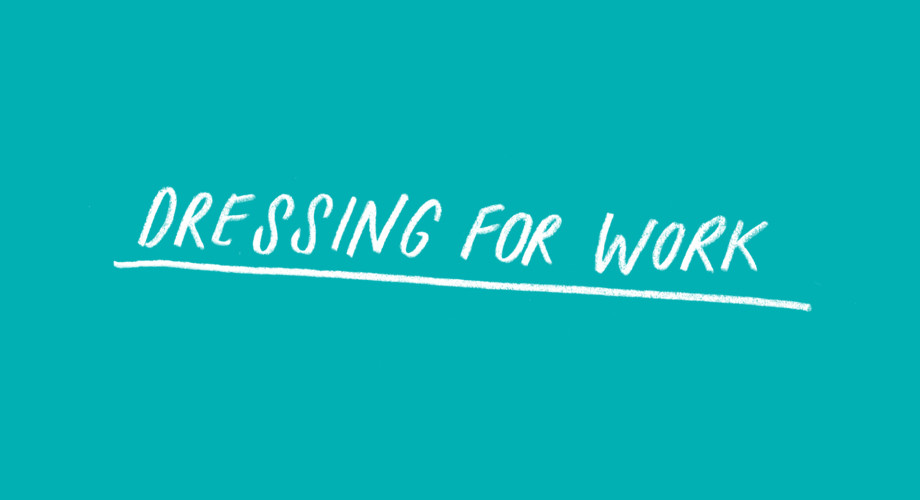In the Blog
Dressing for Work

Image by Erin McPhee
For some women-identified and femme folks, deciding what to wear to work is a deliberate and thoughtful decision. For others, deciding what to wear to work is a quick process often determined by whatever article of clothing is readily available. For many, deciding what to wear to work is a complicated process. An overlooked fact about professional dressing is that for many people, decisions about professional dressing involves untangling mainstream, Eurocentric ideas of what women are told to wear.
This process of deconstructing professional dressing is far from simple. Knowing that for femme folks dressing for work can be frought with both emotional and political complications, the process remains difficult. Just because one can make clear the assumptions behind a mainstream beauty ideal, doesn’t mean that societal ideals about body and/or image issues immediately disappear.
What can be helpful is trying to make professional dressing something you can feel somewhat comfortable doing. Some history about professional dressing ideals is useful.
During the 1980s, messages about how cis - women could get ahead in the business world and the art of power-dressing’ were commonplace. According to the National University of Singapore’s guide on how to execute power-dressing, “power-dressing refers to a mode of using clothing as currency to barter goodwill”. In the guide, what a person wears to work conveys, “messages of status: authority, power, rank; personality: friendliness, dependability, adventurousness; class distinction: upper-, upper middle-, or lower middle-class; character and taste: trustworthiness and good judgment.”
Power-dressing for working women in the 1980s’ era workplace involved shoulder pads, box-cut jackets, peg-legged trousers and if dresses were involved they were always A-Line dresses (think Seinfeld’s Elaine Benes’ business attire when she worked at the Peterson Catalog).
Specifically, if dresses were worn, informal knowledge shared by other women in the workplace would dictate that cellulite on the body be hidden, as though it were a disease. According to the University of Maryland Medical Center, cellulite is defined as, “fat that collects in pockets just below the surface of the skin. It forms around the hips, thighs, and buttocks. Cellulite deposits cause the skin to look dimpled.” Although likening cellulite as a disease is still common practice by many fashion stylists today, did you know that it is actually an invented disease? According to a user comment in a 2012 article by Jezebel.com, “the first time cellulite appeared in English was in a late 60’s issue of Vogue”. The term seems to have caught on and stuck in popular imagination despite no medical studies ever being published likening having cellulite to having a disease.
What’s clear from reading about the historical context of professional dressing for women is that it is a minefield at every turn. It seems as though historical ideas communicated about professional dressing are more about selling certain items of clothing than helping femme folks prepare to do work in their relevant profession.
So what are you to do if want to dress for your job? Below are some basic tips that I have gathered from three months’ research of talking to my femme friends about how they get ready for work.
Acknowledge that Eurocentric ideals in dress codes exist
Disrupt Eurocentric dress codes as much as possible
Assess the degree of flexibility that you have at work to incorporate your own personal style
Consider the different contexts you will have to be in at work. This includes asking questions like, how often will you interact with clients?
Ask your direct report about the acceptable dress code. This is also a good time to ask about what the workplace scent code is. Scent code refers to the workplace policy around scents and fragrances. While many workplaces don’t have an official policy in place for what kinds of perfumes, colognes or scented products an employee can wear – it is a good idea to be conscious of others who may have chemical sensitivities to conventionally scented products.
Another resource that was helpful for me was finding an online community dedicated explicitly to sharing dress code ideas between racialized women and femme folks. A Tumblr blog called, Girls Dressing Cute for Work has been my go – to resource to access workplace dress ideas in a space curated specifically by women of colour but open to a broader audience.
It is never going to be easy to know exactly what one is going to wear professionally and also be comfortable in because self-presentation is a fluid and ongoing process. However, it is possible to incorporate elements of your own personal style, and feel your best in the workplace.



